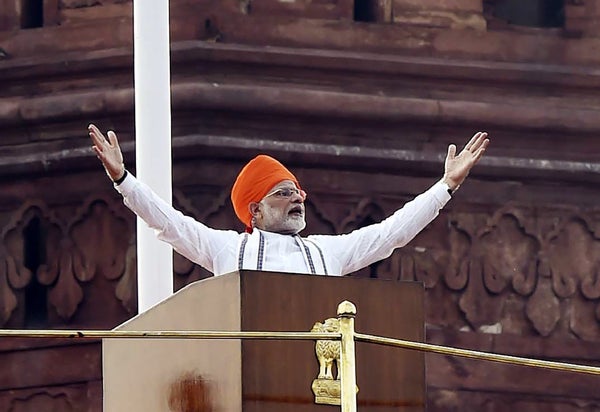India’s Prime Minister Narendra Modi has announced a plan to send humans to space by 2022, when the nation will celebrate the 75th anniversary of its independence. If successful, India will join Russia, the U.S. and China in the elite club of countries to achieve homegrown human spaceflight. India’s only citizen to travel to space as yet has been Rakesh Sharma, a pilot in the country’s air force who orbited Earth in 1984 as part of the Soviet Union’s space program.
The planned Gaganyaan (Sanskrit for “sky craft”) mission aims to send a three-person crew to low Earth orbit for up to a week. In keeping with the localized naming traditions set by U.S. astronauts, Russia’s cosmonauts and China’s taikonauts, Gaganyaan crew members will be called “vyomanauts”—a moniker derived from vyoma, the Sanskrit word for space.
Kailasavadivoo Sivan, chairman of the Indian Space Research Organization, or ISRO, is confident about the 2022 deadline. “Most critical technologies required for the Gaganyaan program have been developed by ISRO engineers,” he says. “ISRO has also successfully demonstrated the prototype of the crew module, a capsule to take humans to space, as well as a launch-abort system, which is needed to eject the crew in case of a failure.” Next, Sivan says, come the more intricate aspects of the program: ensuring the rocket and crew module meet stringent safety requirements, developing life-support systems and heat shields for atmospheric reentry, and constructing communications and crew-training facilities. The program’s entire cost, Sivan says, will be less than the equivalent of $1.4 billion.
On supporting science journalism
If you're enjoying this article, consider supporting our award-winning journalism by subscribing. By purchasing a subscription you are helping to ensure the future of impactful stories about the discoveries and ideas shaping our world today.
From humble beginnings in the 1960s and ‘70s—when India began developing its first rockets and satellites—the nation’s space program has blossomed. Besides partnering with other spacefaring countries on a variety of missions, India has also launched scores of satellites and even two farther-flung craft: Chandrayaan 1, its lunar orbiter, operated at the moon from 2008 to 2009; its Mars orbiter, Mangalyaan, reached the Red Planet in 2013. Specific plans for a crew to fly date back to at least 2006, according to G. Madhavan Nair, a space scientist who served as ISRO’s chairman from 2003 to 2009. That was the year the agency completed a study advocating such a project as the next logical step for India’s burgeoning space program, and began lobbying the government for formal approval and further funding.
But this series of successes has been accompanied by setbacks typical of any country striving to advance in spaceflight, such as occasional launch failures and faulty satellites. The launch of India’s next high-profile space science effort, Chandrayaan 2—which aims to orbit the moon and place a lander at the lunar south pole—has been delayed twice in the past year and is now slated for January 2019.
Even so, A. S. Kiran Kumar, former ISRO chairman and one of the masterminds behind Chandrayaan 1 and Mangalyaan, is ebullient about the 2022 deadline for India’s human mission. ISRO, he notes, has for many years been diligently advancing the core technologies for human spaceflight. The nation has selected its newest, heaviest and most powerful rocket, the GSLV Mk III, to carry its crews to orbit, and Kumar says multiple test flights in the next few years should further refine the rocket’s capabilities. Nair shares Kumar’s optimism about the GSLV Mk III as well as meeting the 2022 deadline, but he worries “India hasn’t yet started the process of selecting and training astronauts for the mission”—a task that is time-consuming. To accelerate the crew selection process, Nair says, ISRO may seek collaborations with the U.S. or Russian space agencies.
Also, not every Indian aerospace expert is so sanguine about the nation’s rocketry being ready in time. Ajey Lele, a senior fellow in the Institute for Defense Studies and Analyses in New Delhi, says “the major problem is going to be the availability of the rocket for the mission. ISRO needs to make the GSLV Mk III operational—fast.”
A more fundamental (and political) concern facing India’s pursuit of a domestic human spaceflight program may be balancing such aspirations against its goals of continuing its economic development and lifting more of its citizens out of poverty. Kumar, however, sees India’s space program not as a frivolous distraction from this goal but rather as an affordable necessity that will create new jobs and lead to technological spin-offs, which enhance and stimulate development. “It is necessary to meet the growing needs of the economy,” he says. “Space has become the fourth frontier after land, air and water.”
ISRO’s total budget since its establishment, he notes, is less than what NASA now spends in a single year; this is in keeping with India’s major space successes being achieved at remarkably low costs compared with its global counterparts. At $78 million, its Mars mission cost less than the production and marketing of a typical Hollywood movie. And if ISRO’s budgetary projections hold, its first human spaceflight will consume roughly one seventh of what NASA is spending on a single space observatory, the $9.6-billion James Webb Space Telescope.
